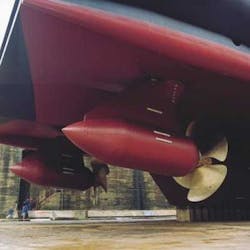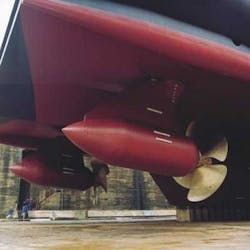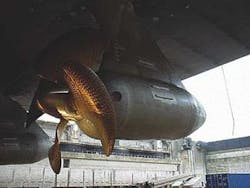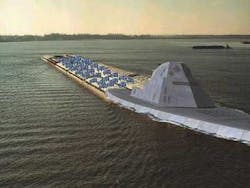All-electric ships
Navy eyes high-power components for future all-electric ships
Warship designers until now have used hydraulics, pressurized air, and steam to move large masses, such as aircraft catapults, aircraft elevators, and ship propulsion systems, yet new advances in high-power electronic devices may lead to all-electric power aboard surface vessels.
By J.R. Wilson
The latter half of the past century saw nuclear power, computers, and precision-guided rocketry greatly increase the capabilities and killing power of naval warships. While those technologies improved through the decades, the next evolution in ship design is expected to alter naval maritime architectures so dramatically that it has been compared to the transition from sail — to steam — to nuclear power.
This next evolution, called advanced electrical power systems (AEPS), involves the conversion of virtually all shipboard systems to electric power — even the most demanding systems, such as propulsion and catapults aboard aircraft carriers.
AEPS "will provide the enabling science, technology, and design tools to allow electrical power systems, electric propulsion, and auxiliary systems to meet future mission and affordability requirements," according to experts in the U.S. Office of Naval Research in Arlington, Va. AEPS technologies will be applicable to all future surface ships, aircraft carriers, and submarines.
AEPS, in short, will provide the foundation upon which to build fleets of all-electric ships — otherwise known as AESs. Ship designers are already working on all-electric ship concepts in programs such as:
- the U.S. Navy's next-generation destroyer, known as DD(X);
- the British Royal Navy's Daring-class Type 45 destroyer;
- the French navy's Forbin-class Horizon future anti-air warfare frigate; and
- the Italian navy's Bergamini-class Horizon frigate.
If current program schedules hold, the British, French, and Italian ships will enter service between 2006 and 2009, while the U.S. Navy DD(X) will enter service in 2011.
"Any discussion of transformation in the Navy should start with DD(X)," Assistant Secretary of the Navy (Research, Development, and Acquisition) John Young Jr. told the Surface Navy Association in January. "I am convinced that the family of combatants, led by DD(X), is essential to the future of the Navy."
Brian Pope, president of Alstom Transmission & Distribution in Philadelphia, says the military is in a follow-on role when it comes to all-electric ships, which have been in operation in the commercial world for more than a quarter century, from cruise ships and tankers to deep-water drilling ships and ice breakers, all with fully integrated electric propulsion systems.
"The [oceanliner] QE2 was converted from steam to all-electric in the 1980s," he notes. "So we can do an all-electric ship — the technology is here today. That is the key. In fact, the commercial technology has now gone to the point where the electric motor is put into a pod outside the hull form. The Queen Mary II, now being built as the largest oceanliner in the world, will have the power plant in four pods — the largest pods in the world — outside the hull. This is double the size of the QE2 with 88 megawatts installed, which is approaching the size of a nuclear carrier.
"I can envision that coming in the military world, eventually, but it wouldn't have the hull to protect it," Pope says. "Still, that allows some creativity in the hull form that provides greater efficiency through the water. That is the next stage in the development of ships, but we have to first get the Navy into a full electric ship with conventional designs."
DD(X) program manager Capt. Charles Goddard points to the Navy's first planned all-electric ship's integrated power system (IPS) and electric-drive propulsion plant as the heart of its transformational status, influencing not only propulsion but also weapons, support, maintenance, and manpower.
"DD(X) is the first truly network-centric surface combatant," Goddard told the Navy League of the United States recently. "In addition to the ship's large payload capacity, it will have a high C4I [command, control, communications, computers, intelligence] fraction, with warfare and information-systems capabilities equivalent to those on today's carriers. We are on the cutting edge of ship survivability and signature reduction and our radar, undersea warfare, and integrated power systems are state-of-the-art."
Current Navy plans call for eight DD(X)-class ships to begin construction between 2005 and 2009. The British sea map calls for 12 Type 45s to enter service as replacements for the Royal Navy's ageing Type 42 frigates, while France and Italy currently are calling for two of the jointly built Horizon frigates each.
null
null
Also planned as an all-electric ship is the CVN-21 (nee CVN-X) next-generation U.S. Navy carrier, currently in Phase II design and scheduled for launch around 2011 to 2013 to replace the then half-century-old USS Enterprise (CVN 65).
The CVN-21's new nuclear reactor not only will provide three times the electrical output of current carrier power plants, but also will use its integrated power system to run an electromagnetic aircraft launch system (EMALS) to replace the current steam-driven catapults. Combined with an electromagnetic aircraft recovery system (EARS), EMALS will enable the new carrier to conduct high-intensity aircraft launch and recovery operations consistently with minimal recovery or maintenance downtime.
Two contractor teams, led by General Atomics in San Diego and Northrop Grumman Marine Systems in Sunnyvale, Calif., will conduct an EMALS "shoot-off" this summer at the Naval Air Warfare Center Aircraft Division in Lakehurst, N.J. The goal of the EMALS effort is to reduce the manpower requirement for catapult operations by 30 percent, reduce the life cycle cost by $1 million per year per unit, improve operational availability by 20 percent, and improve fault tolerance.
"An electric ship doesn't just mean using electricity to drive the ship through the water," explains Cmdr. Roger McGinnis, program manager for directed energy and electric weapons at Naval Sea Systems Command (NAVSEA) in Washington. "Today, most of the electricity on a ship is direct-linked to the propulsion system, which means 90 percent of the time we're not using the majority of the power on the ship.
"The real step we're looking to is an integrated power system, where all power is made available to the entire ship," McGinnis says. "On today's ships, we may have 4 megawatts available to hotel services and combat systems; on future ships, we may have 50 to 100 megawatts; it's only limited by the number of generators you put on board."
Integrated power system also will be the enabling technology for a change from rocket-assisted and gunpowder-based weapons to 21st century electric weapons with a host of advantages.
Power for weapons
"All the weapons we have today have electric components, but electric weapons will use that substantial increase in power as the weapon itself," McGinnis says. "For directed energy weapons, having the raw power available in the first place is the real enabling technology," McGinnis says. "The free electron laser (FEL) is the primary one the Navy is interested in because we believe it can scale. It could be used to protect a ship against cruise missiles, for example, anti-ship missiles. It also doesn't have the poisonous exhaust problem of a chemical laser or the thermal problems of current solid-state lasers.
"We can use cryogenic technology to develop that and on the high-power microwave," McGinnis continues. "The high-power microwave system — called the active denial system — allows you to set up an electric fence around something to prevent people from entering that area. For a ship at sea, you could set up a perimeter around the ship; it is designed to be non-lethal, it just heats the skin up very fast and would force an intruder to turn away. It is being thought of with respect to the Cole attack, but the primary interest in the Navy is for protecting shore facilities."
Lasers as weapons also greatly improve the flexibility of the ship's armament.
"The laser will also add precision-engagement capability — you can aim, shoot, and know what you will hit, whereas there is a high probability of collateral damage with a kinetic weapon," McGinnis says. "Directed energy also has variable lethality, so you can use low power as a warning device."
Fred Beach, NAVSEA's assistant program manager for the electric railgun, says the integrated power system has also made it possible to provide the extremely high peak powers required for an electromagnetic (EM) railgun, which can fire projectiles at hypersonic speeds.
"An EM gun utilizes gigawatts of power, but only for five or ten milliseconds. That needs to be stored so it can be released, which is also true of the catapult," Beach says. "The key is having an intermediate energy storage system that can release the power as required. From a capacitor approach, those systems exist today. Ships, by the very nature of their size, have the amount of energy available and those will be seen there long before they are seen on aircraft or tanks or wheeled vehicles, because of the power availability."
null
Joel Ennis, product line manager for General Atomics Energy Products in San Diego says he and his staff of experts are working to integrate their energy storage and pulse-discharge capacitors into applications such as railguns, active armor, catapults ,and directed-energy weapons.
"A pulse discharge capacitor is used to compress power; you feed in energy over a long period of time, then discharge it in micro or milliseconds. That provides a high peak power, which provides the impact for lasers and other applications," Ennis says. "For a railgun, you might charge the capacitor for several seconds, then discharge it in milliseconds," he says, adding that achieving those levels of power in a system small enough to fit on a ship requires high energy densities. "We achieved volumetric energy densities of 4 joules per cubic centimeter during the 1980s; we've built capacitors as large as 40,000 joules.
"There were several years during which that technology languished due to lack of funding, but now there has been a resurgence of interest," Ennis continues. "Recently, we've combined what we learned in the early 1990s on the military side and what we've learned since then on commercial development and achieved significantly higher densities in smaller scales, on the order of 5.8 joules per cubic centimeter. A five-year target would be to get to 8 joules per cubic centimeter. That is approaching a level where you could put a railgun on a tank."
Designs similar to those of EM guns and EMALS also can adapt to other applications, such as replacing gunpowder and booster rockets in a variety of weapons systems, as well as powering carrier elevators and other major systems.
"Anything done on a ship that requires moving mass historically has used steam, hydraulics, or air under pressure, but any of those things can be done with electric systems. We could even replace the vertical launch systems on ships with something similar to the EMALS that could launch Tomahawk cruise missiles without rocket boosters," Beach says. "The Tomahawk has a highly energetic rocket booster that could be replaced by an electromagnetic system to launch them and still maintain controlled flight. The same is true for any Standard missiles launched from vertical launch systems. Those are rockets, but they need other rocket launch systems to lift them out of the ship before they light off. That would eliminate the heat and plume from the ship.
"You will always be able to track something back, but it is better not to have a huge thermal register still on the ship, which can move after launch," Beach says. "If that thermal signature remains, it is a lot easier for the enemy to find you."
Plans to design all-electric ships have put a renewed emphasis on directed energy and EM railgun research, which Beach says has been languishing for the past two or three decades for lack of a practical way to use them. But the future still is not assured.
"The Navy is coming to a key decision point — do we want to go to electric-drive ships with electric weapons? We need to make those decisions now," he says. "By my definition, an electric ship has electric weapons; otherwise, it's just an electric drive for ships."
Thermal considerations
There are still significant problems that must be addressed before a true all-electric ship is ready to sail. One of the most important — influencing everything from microchips to rocket launchers — is heat; thermal management has been identified as an enabler of the electric warship, which will require an evolution in advanced cooling technology to be operational for power electronics.
"The integrated power system in the all-electric ship will be creating heat loads that are twice as high as what we have now," says Mark Zerby, a mechanical engineer at the Naval Surface Warfare Center Carderock Division (NSWCCD) in Philadelphia. Zerby has worked for the last four years to define thermal-management requirements for the Next Generation Navy and to identify emerging thermal-management technologies for future naval vessels. "In going from a mechanical drive to an electric drive, all the electronics involved will be creating new sources of waste heat. The quality of the power they will need will have faster switching speeds and smaller components, which will generate more waste heat," Zerby says.
"We're looking at a combination of component and system cooling solutions," Zerby continues. "That will require advanced cooling technologies, such as thermoacoustic coolers that use sound to create cooling by taking advantage of the compression and expansion associated with sound waves; when you compress air, it is hotter; when you expand it, it is cooler. The frequency used would be tied to the physical size of the device — a single chip would use a very small device with a higher frequency than one designed for a larger component."
Other potential technologies to replace existing air conditioning plants aboard naval vessels include thermoelectrics and magnetic refrigeration. At present, magnetic refrigeration is in the early development stage, thermoacuoustics are in prototype, and thermoelectric has had some application in Navy ships. The question for all is improving efficiency.
Zerby says material advances, smaller electronics components, and faster switching speeds eventually will force the rate of heat flux to exceed 1,000 watts per square centimeter. Add to that advanced power electronics and radar, dynamic armor and weapons systems such as the EM railgun and the FEL and future warship heat loads eventually could require a seven-fold increase in cooling capacity.
Testing the Design
In making the move to all-electric ship designs, Navy experts say they want to test each concept and component as thoroughly as possible before committing it to construction. While the historic approach has been to use simulation first, then go to a land-based, almost full-scale ship segment for testing, they want to emulate an all-electric ship in eight or nine zones, then build one zone to which they could interface a simulation of all the remaining ones.
"That would put the actual amount of power needed into the real system and the computer would monitor the response and feed it back into the simulation. So the hardware would function as if it were actually in the ship and fully integrated with all the other zones," explains Sean Vallieu, senior research engineer at F&H Applied Science Associates Inc. in Mount Laural, N.J. "That also would allow a vendor to hook up a proposed new system into the hybrid to test without risking putting it into a real ship once it was completed."
Toward that end, F&H is in research and development on an electric machinery evaluation system (EMES), which Vallieu says will "de-risk technology insertion in new and existing shipboard electric systems."
"The EMES has three parts if you include the hardware you are testing," he says. "The other two are a valid simulation of the power system, which is by no means a trivial element, and a simulation of the interface between that power system and the hardware being tested. We have to take the power simulation output and convert it into real power to perform the test, then monitor the response of the hardware and feed it back into the simulation. The interface translates the computer output into real power, then takes the response of the hardware in the test and translates it back into the simulation."
The University of South Carolina's Virtual Test Bed will help experts create the power simulation. F&H's interface is a controlled power source for the test hardware, so it has to be hooked up to an external power source sufficient to provide the needed level of output.
"Our element is both hardware and software; how large it is depends on the power level being simulated," Vallieu says. "If the computer says it is creating — say 208 volts AC at 10 amps — about 2 kilowatts of power — then our interface takes that time-varying waveform, including all the noise that would be present in an actual power system, converts it to an analog signal, and creates an actual electric output to match it. It also monitors the current delivered to the hardware under test and whatever feedback is created by that hardware — voltage across the load, for example — which is then fed back into the simulation. The simulation is a mathematic model and needs data feedback in numbers it can understand.
"The difficulty in all this is not only creating an accurate power simulation — which is hard enough — but also ensuring the EMES is an accurate emulation of the real ship's systems, so the test hardware does not know the difference between being connected to our simulation and being installed in a real ship," Vallieu says.
In their current research phase, F&H experts are working with a 100-watt prototype, although they say they hope to have a 2-to-10-kilowatt prototype in operation by year's end. To develop a functioning system, however, would require having a real ship's power system with which to make comparisons, then building a sufficient controllable power source, all of the necessary sensors to measure feedback, a converter to go from the computer to the power source, and the hardware to make the translation in both directions. If all goes well, Vallieu estimates that might be possible in three to five years.
"You could do this for any electrical system, so it could be used to test prospective hardware for aircraft, an electric tank or whatever," Vallieu says. "We're also looking at eventually using it to validate survivability of a power system in the event of a terrorist attack, for example, to see how system elements react to damage. For example, they had problems with telephone switching equipment on Sept. 11; we could test how such a system would react in the future."



